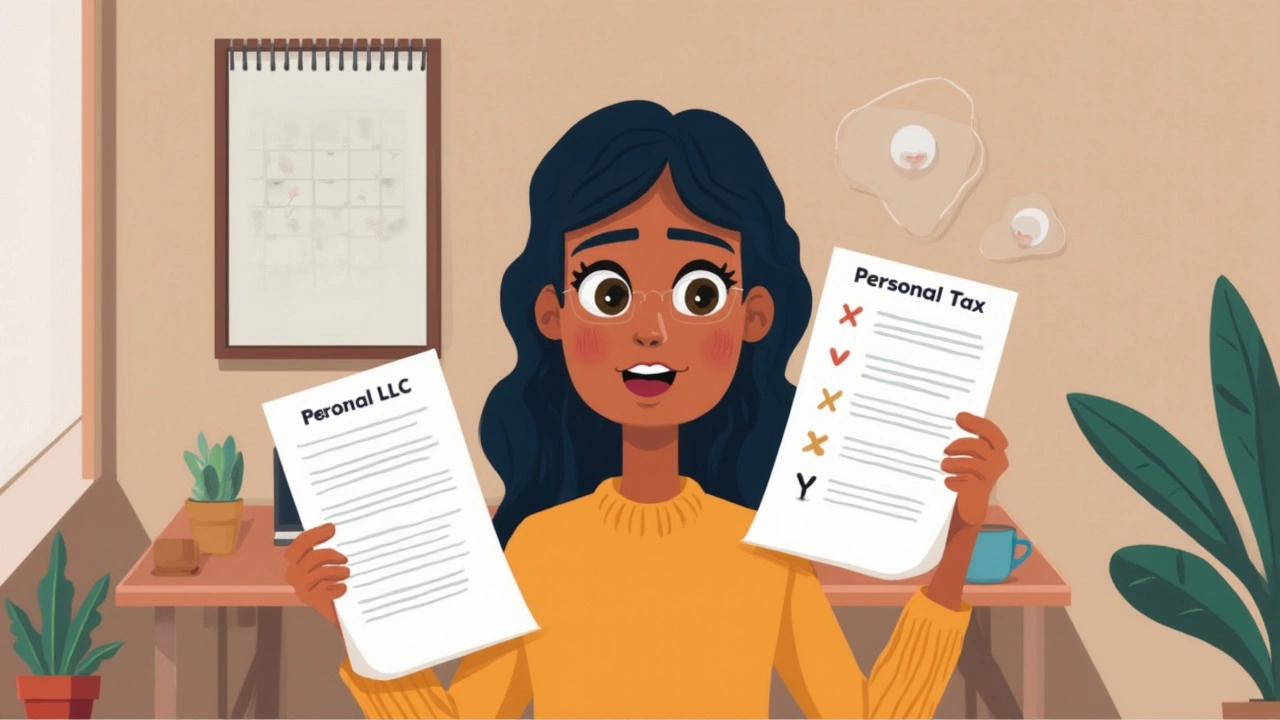Figuring out how to file taxes for an LLC throws a lot of folks for a loop, especially the first time around. Here’s what you really need to know: whether you combine your personal and business taxes depends entirely on how your LLC is set up with the IRS. There isn’t one single answer that works for every LLC owner.
Most single-member LLCs are treated as “disregarded entities.” That means, tax-wise, your business is basically invisible to the IRS—you report all your business income and expenses right on your own personal tax return, using a Schedule C. No separate business tax return required. Sounds simple, right? But things get messier when you have a multi-member LLC, or if you choose to have your LLC taxed as a corporation.
Before you rush into tax season, you need to know what rules apply to your exact situation. If you don’t, you could file in the wrong place, miss out on deductions, or even get stuck with penalties. Trust me, you want to avoid surprises when it comes to the IRS.
- LLC Taxes: Understanding the Basics
- When You File Together (or Not): The Scenarios
- Personal Tax Filing with an LLC: What Changes?
- Common Mistakes and Easy Fixes
- Pro Tips for Stress-Free LLC Tax Filing
LLC Taxes: Understanding the Basics
An LLC (Limited Liability Company) seems straightforward at first, but the IRS has a funny way of keeping things interesting. The way your LLC pays taxes depends on how many owners it has and how you choose to have it taxed. Here are the main ways the IRS looks at LLCs:
- Single-member LLC: The IRS treats it as a “disregarded entity.” This means for federal tax purposes, it's not seen as separate from the owner. You put your LLC’s profits and losses right on your personal tax return (Form 1040, Schedule C).
- Multi-member LLC: Automatically treated as a partnership by default. The LLC files a partnership tax return (Form 1065), and then each member puts their share of profits and losses on their personal tax return using a Schedule K-1.
- LLC taxed as a corporation: You can file paperwork (Form 8832 or 2553) to have your LLC treated as a corporation—either C corp or S corp. In this case, the LLC files a separate business tax return just like any other regular corporation.
Your state may also have LLC tax rules that stack on top of all this, so don’t forget to check what’s going on locally.
The IRS says, “By default, a domestic LLC with only one member is not recognized as a separate entity for federal income tax purposes, and must report income and expenses on the member’s federal tax return.” (irs.gov)
Eager to see some data? Check out this table—way more people pick the default (pass-through) tax set-up than anything else. In 2023, according to the National Federation of Independent Business (NFIB), almost 80% of LLCs went with default taxation.
| LLC Tax Status | % of LLCs Using It (2023) | Required IRS Forms |
|---|---|---|
| Disregarded Entity (Single-member) | 53% | Schedule C (1040) |
| Partnership (Multi-member) | 27% | Form 1065 & Schedule K-1 |
| C Corporation | 12% | Form 1120 |
| S Corporation | 8% | Form 1120-S & Schedule K-1 |
The bottom line: Your LLC’s tax path isn’t just about what kind of business you run—it’s about the number of owners and how you want to pay taxes. Figuring out your setup now saves confusion (and stress) later on.
When You File Together (or Not): The Scenarios
This is where things get real for LLC owners: do you file your business and personal taxes together or keep them separate? It all comes down to how your LLC is set up in the eyes of the IRS.
Let’s break down the main setups and what they mean for your tax filing:
- Single-member LLC: If it's just you, the IRS treats your LLC as a “disregarded entity.” That’s just a fancy way of saying you report all your LLC income and expenses on your own personal tax return (Form 1040 using Schedule C). You’re not filing a separate business return—your LLC taxes are part of your personal taxes.
- Multi-member LLC: Got business partners? Your LLC is seen as a partnership for tax purposes. The company files its own “informational return” (Form 1065), but the profits and losses “pass through” to the owners, who report it all on their personal tax returns (on a special form called Schedule K-1). You each pay tax on your share, not as a group, but you do need both the partnership return AND your own return.
- LLC taxed as an S corporation: Maybe you elected S Corp status for extra tax savings. Now, your LLC files Form 1120-S, and each owner gets a K-1 showing their share of profits or losses to put on their personal return. So yes, you still file a personal return, but there’s definitely extra IRS paperwork too.
- LLC taxed as a C corporation: Some go this route for big-growth plans. The LLC files a separate business return (Form 1120), pays corporate taxes, and if it pays you dividends, those show up as income on your personal return. It’s totally separate—no mixing.
So, for most people with a single-member LLC, it all gets mixed in with your own taxes. If you’ve got partners or a more complex structure, expect to handle both business and personal returns, even if some info overlaps. Knowing your setup ahead of time saves headaches and missed deadlines.

Personal Tax Filing with an LLC: What Changes?
So you’ve got an LLC—how does that change the way you file your personal taxes? It mostly comes down to how many people are in your LLC and what you told the IRS about how you want to be taxed. Here’s how it breaks down:
- Single-member LLC: For most folks, this is the simple version. You put all your LLC income and expenses straight onto your personal tax return (Form 1040), using a Schedule C attachment. No separate tax return for the business. Your profit (or loss) goes straight into your own tax situation and affects what you owe. You’ll also need to pay self-employment tax on any LLC earnings, and you might even need to file a Schedule SE.
- Multi-member LLC: This is treated like a partnership. The LLC itself files a Form 1065 partnership tax return. Then each member gets a Schedule K-1 showing their share of the profits or losses—which you’ll enter on your own personal return. You don’t report all business details on your 1040, just your share from the K-1.
- LLC taxed as S corp or C corp: If you made an election for corporate tax treatment, the game changes. Now, your LLC files its own tax return (1120S for an S corp, 1120 for a C corp). You might get a K-1 (S corp) or a W-2/salary from the business, and you only report those amounts on your personal return—not every single business detail.
Single-member LLCs make up over 70% of new LLCs in the U.S., just because the tax process is so much easier for most freelancers and small business owners. Here’s a quick cheat sheet to show you the main filing forms:
| LLC Setup | Business Tax Return Needed? | Personal Tax Form Needed |
|---|---|---|
| Single-member LLC | No (reported on Schedule C) | 1040 + Schedule C |
| Multi-member LLC | Yes (Form 1065) | 1040 + Schedule E (K-1 info) |
| LLC taxed as S corp | Yes (Form 1120S) | 1040 + K-1 (or W-2 if owner is on payroll) |
| LLC taxed as C corp | Yes (Form 1120) | 1040 + W-2 or dividends |
Here's a small but important tip: If you run a single-member LLC, you can still take all your usual deductions—like home office expenses, mileage, or supplies—right on your Schedule C. Just make sure you keep rock-solid records to back them up if the IRS comes asking.
Remember, your state might have separate rules, too. Some states require a separate LLC tax filing, even if the feds don’t. Don’t let this one sneak up on you—always double-check your state’s requirements before tax time.
The main thing to keep in mind: The way you handle LLC taxes on your personal return depends a lot on how you set up your business with the IRS. Don’t just guess—look at your LLC’s paperwork, and if you’re not sure, talk with a tax pro so you get it right the first time.
Common Mistakes and Easy Fixes
People mess up their LLC tax filing all the time, even if they’re careful. The good news? Most mistakes have simple fixes, if you catch them in time. Here are some common traps and what you can do about them:
- Mixing up personal and business expenses. It’s easy to swipe the wrong debit card or pay a bill from your personal account, but this muddies the waters come tax time. Always keep separate accounts for your LLC and your personal stuff. If you slipped up, flag the transaction, document what happened, and keep it clear for next year.
- Using the wrong tax form. Single-member LLCs almost always need a Schedule C with their personal 1040. Multi-member LLC? You’re looking at Form 1065 for the business and a K-1 for each member’s personal filing. If you filed just your 1040 and skipped the Schedule C, or missed the K-1, you might get a letter from the IRS. It’s fixable—just file an amended return (Form 1040-X) with the right info.
- Forgetting to pay self-employment taxes. With LLC profits, the IRS expects you to pay more than just income tax—you owe Social Security and Medicare parts, too. Miss those, and not only do you owe interest, but you may face penalties. Use the Schedule SE to report and pay your share. Missed a payment? Make up for it fast; the longer you wait, the bigger the penalty.
- Not checking your state’s requirements. Some states want a cut, too—sometimes a yearly LLC fee or their own business income tax. California, for example, hits LLCs with an $800 annual minimum tax even if you made no money. Don’t forget to file these, or you could lose your business standing or rack up extra fines.
If you catch a mistake after filing, don’t freak out. The IRS knows we're human. Look up the right amendment form or talk to a tax pro—fixing things sooner is always better. Last tip: using software or a qualified tax preparer makes these headaches a lot less likely, especially if you’re new to LLC taxes.

Pro Tips for Stress-Free LLC Tax Filing
Want to avoid that nervous tax-time scramble? It’s totally possible. Whether you’re running a single-member setup or splitting your LLC with partners, being organized and informed is your secret weapon. Here’s a set of hands-on tips and some cool facts to keep the IRS happy and your stress level low.
- LLC taxes can get messy, so keep business and personal bank accounts separate. When you blend your cash, tracking deductible expenses turns into a headache fast. Open a dedicated account, even if you’re the only owner.
- Track your expenses year-round—not just in March. Use a simple spreadsheet, accounting software like QuickBooks, or even a smartphone app. Snap photos of receipts; the IRS will accept digital copies if you ever get audited.
- Know your deadlines. Single-member LLCs report profits and losses on your personal taxes (due April 15), but multi-member LLCs file Form 1065 and give each partner a K-1—those go out by March 15. Miss those dates, and late fees kick in quick.
- Save a chunk of every payment for taxes. A safe bet is 25-30% if you’re self-employed. Quarterly estimated taxes are a thing, and ignoring them can lead to some serious penalties.
- If you don’t know something, ask. Accountants and tax pros might seem pricey, but a single visit can keep you out of big trouble (and often pays off in savings).
Let’s be real, the IRS is notorious for paperwork. Here’s a handy bite-sized comparison for filing types—all numbers are straight from the latest tax year.
| LLC Structure | Main Tax Form | Due Date | Extra Notes |
|---|---|---|---|
| Single-Member LLC | Schedule C (1040) | April 15 | All profits/expenses reported on personal tax |
| Multi-Member LLC | 1065 (plus K-1s) | March 15 | Each partner gets a K-1 for their share |
| LLC electing S Corp | 1120S | March 15 | Pay yourself a salary; file payroll taxes too |
| LLC electing C Corp | 1120 | April 15 | Double taxation risk, need business return |
Quick tip: Over 70% of new LLCs skip the estimated tax payments and get hit with penalty bills. Make those payments every quarter, and you’ll glide through April without any nasty surprises.
Finally, check for special local fees or filings in your city or state. Some states (like California) want their own annual LLC forms or franchise taxes, totally separate from the IRS. Missing them can get pricey, and those notices arrive when you least expect it.


